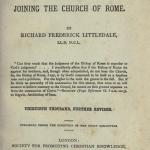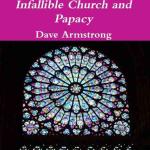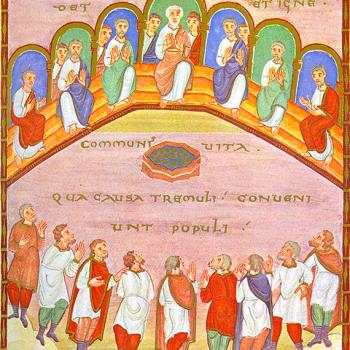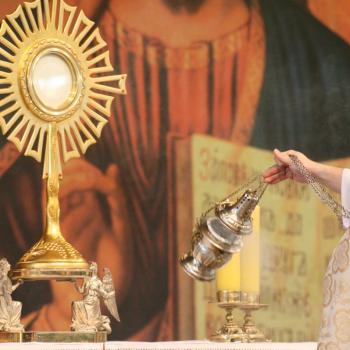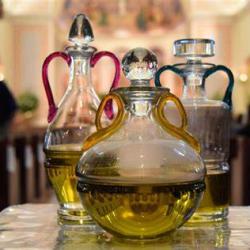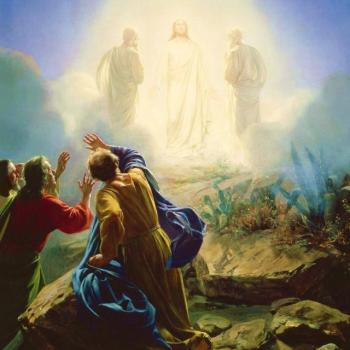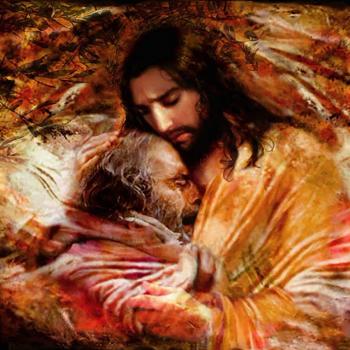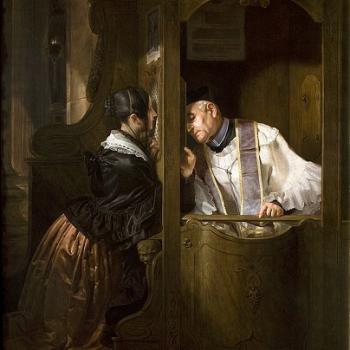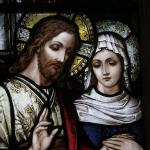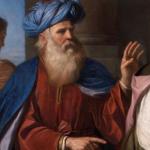“Please Hit ‘Subscribe’”! If you have received benefit from this or any of my other 4,600+ articles, please follow this blog by signing up (with your email address) on the sidebar to the right (you may have to scroll down a bit), above where there is an icon bar, “Sign Me Up!”: to receive notice when I post a new blog article. This is the equivalent of subscribing to a YouTube channel. Please also consider following me on Twitter / X and purchasing one or more of my 55 books. All of this helps me get more exposure, and (however little!) more income for my full-time apologetics work. Thanks so much and happy reading!
***
I am responding to the book, Plain Reasons Against Joining the Church of Rome (London: Society for Promoting Christian Knowledge, 1880), by Richard Frederick Littledale (1833-1890), an Anglo-Irish clergyman and prolific author. He received LL.B. and LL.D. degrees from Trinity College Dublin, in 1862, and a D.C.L. from Oxford. He was renowned as a father confessor, and next to Edward Pusey is said to have heard more confessions than any other priest of the church of England. His Plain Reasons Against Joining the Church of Rome, a volume of which thirty-six thousand copies were issued in 1880 and following years, evoked replies from the Rev. W. Horsfall, the Rev. A. Mills, Oxoniensis, and H. I. D. Ryder. I’ll be addressing various irrational arguments against intercession of saints, found in this book on pages 28-60. His words will be in blue.
***
the whole practice of the Invocation of Saints is founded on pure guesswork. Not one syllable can be discovered in the Old or New Testament which gives the least ground or suggestion of it; God has never been pleased to reveal it, . . . (p. 31)
The best disproof of this claim is in the story of the rich man and Lazarus:
Luke 16:24 (RSV) And he called out, ‘Father Abraham, have mercy upon me, and send Laz’arus to dip the end of his finger in water and cool my tongue; for I am in anguish in this flame.’
This is the Abraham of the Bible: long dead by that time, being asked to do something by a “rich man” (16:19, 22). His answer was, in effect, “no” (16:25-26). Thus failing in that request, he prays to him again for something else:
Luke 16:27-28 And he said, ‘Then I beg you, father [KJV: “I pray thee therefore, father”], to send him to my father’s house, [28] for I have five brothers, so that he may warn them, lest they also come into this place of torment.’
His request is again declined (16:29). So, like any good self-respecting Jew (Moses even “negotiated” with God), he argues with Abraham (16:30). But Abraham states again that his request is futile (16:31). Abraham is asked to “send” a dead man to appear to the rich man’s brothers, in order for them to avoid damnation (yet another [potential] instance of dead men — like the prophet Samuel to Saul — communicating to those on the earth). Abraham doesn’t deny that he is able to potentially send Lazarus to do such a thing; he only denies that it would work, or that it is necessary (by the logic of “if they don’t respond to greater factor x, nor will they to lesser factor y”).
And this is all told, remember, by our Lord Jesus. It is disputed whether it is a parable or not (several textual factors suggest that it is not; e.g., parables do not use proper names), but even if it is, it nevertheless cannot contain things that are untrue, lest Jesus be guilty of leading people into heresy by means of false illustrations or analogies within His common teaching tool: the parable. Another common retort is that this is a person after death talking to another dead man. But the usual Protestant view is that no one can possibly ever ask any dead person to intercede. That would include other dead men. They’re still doing what we are told is an utterly impermissible act. Jesus would thus be teaching false theology, according to this viewpoint.
Are there any other biblical indications of contact with a dead person? Yes:
Acts 9:40 But Peter put them all outside and knelt down and prayed; then turning to the body he said, “Tabitha, rise.” And she opened her eyes, and when she saw Peter she sat up.
This shows two things (both absolutely anathema to almost all Protestants):
1) St. Peter prayed for the dead (9:40).
2) St. Peter communicated to a dead person (9:40: “Tabitha, rise.”): expressly against what Protestants claim Scripture never allows.
And of course, in this, Peter was only following the lead and example and command of His Lord Jesus, Who said that His disciples would raise the dead, just as He did. And when Jesus raised Lazarus, He, too, talked to a dead man: “Lazarus, come out” (Jn 11:43). And He did so again in the case of the son of the widow of Nain, whom He raised from the dead (Lk 7:11-15): “And he said, ‘Young man, I say to you, arise.’” Therefore, Jesus is again exposed as a false teacher — having given three bad examples of false theology and practice — , therefore, not God, etc., etc. That’s the logical reduction or reductio ad absuurdum, if we are to believe Protestants in this respect. It’s always best to go with Jesus and the Bible.
It is at best a mere conjecture that the Saints do know what passes on earth, and can hear and join in the prayers of the faithful. It may be so, but God has not chosen to make it known to us, . . . (pp. 31-32)
Hebrews 12:1 Therefore, since we are surrounded by so great a cloud of witnesses, let us also lay aside every weight, and sin which clings so closely, and let us run with perseverance the race that is set before us,
The word for “witnesses” is the Greek word martus, from which is derived the English word “martyr.”
1) Greek-English Lexicon of the New Testament (Joseph H. Thayer, Grand Rapids, Michigan: Baker Book House, 4th ed., 1977; orig. 1901, 392) defines it — as used in this verse — as follows: “One who is a spectator of anything, e.g. of a contest, Heb 12:1.”
[Strong’s word #3144; similar usages cited by Thayer: Lk 24:48; Acts 1:8; 1:22; 2:32; 3:15; 5:32; 10:39; 13:31; 26:16; 1 Pet 5:1 – the sense is indisputable in these other verses]
2) Word Studies in the New Testament (Marvin R. Vincent, Grand Rapids, Michigan: Eerdmans, 1980; orig. 1887; vol. 4, 536), another standard Protestant language source, comments on this verse as follows:
‘Witnesses’ does not mean spectators, but those who have borne witness to the truth, as those enumerated in chapter 11. Yet the idea of spectators is implied, and is really the principal idea. The writer’s picture is that of an arena in which the Christians whom he addresses are contending in a race, while the vast host of the heroes of faith who, after having borne witness to the truth, have entered into their heavenly rest, watches the contest from the encircling tiers of the arena, compassing and overhanging it like a cloud, filled with lively interest and sympathy, and lending heavenly aid.
‘Cloud of witnesses’ (nephos marturon . . . The metaphor refers to the great amphitheatre with the arena for the runners and the tiers upon tiers of seats rising up like a cloud. The martures here are not mere spectators (theatai), but testifiers (witnesses) who testify from their own experience (11:2,4-5, 33, 39) to God’s fulfilling promises as shown in chapter 11.
[Note that the notion of “spectators” is the primary metaphor — the arena — so that both meanings: that of spectators and witnesses in the sense of example are present. Neither can be ruled out]
4) Theological Dictionary of the New Testament, (ed. Gerhard Kittel & Gerhard Friedrich; tr. and abridged by Geoffrey W. Bromiley, Grand Rapids, Michigan: Eerdmans, 1985; 567), an impeccable and widely-used linguistic (non-Catholic) source, states: “In Heb. 12:1 the witnesses watching the race seem to be confessing witnesses (cf. 11:2), but this does not exclude the element of factual witness.”
So our four non-Catholic language references all confirm that the element of “spectatorship,” which lends itself to the Catholic notion of communion of saints, where saints in heaven are aware of, and observe events on earth; strongly indicated by Hebrews 12:1, and not able to be ruled out by any means, on the basis of a doctrinal bias.
Moreover, if dead saints and angels cannot ever hear our prayers, what are both of them doing with their prayers in heaven?:
Revelation 5:8 And when he had taken the scroll, the four living creatures and the twenty-four elders fell down before the Lamb, each holding a harp, and with golden bowls full of incense, which are the prayers of the saints;
Revelation 8:3-4 And another angel came and stood at the altar with a golden censer; and he was given much incense to mingle with the prayers of all the saints upon the golden altar before the throne; [4] and the smoke of the incense rose with the prayers of the saints from the hand of the angel before God.
God certainly did make these things “known to us.” But the problem is that some folks just don’t want to hear what God says (if they are already inclined to disagree with it). That’s why Jesus said, “He who has ears to hear, let him hear” (Mt 11:15). Protestants read passages like these, just as we do, but they don’t “register” because they don’t like the “Catholic” implications of them. They’re “Catholic verses”. And Protestants who reject these passages are being insufficiently biblical or respectful of God’s inspired revelation. It’s “pick-and-choose theology.”
we find the first germs of the practice at the close of the fourth century (p. 34)
Not so, since Jesus and Peter taught and practiced it in the Bible some 350 years earlier, as I have already proven.
there is a very suspicious fact which meets us at the outset of the inquiry as to the actual Roman practice, as distinguished from any fine spun theories in books, namely, that many Roman Catechisms omit the Second Commandment, while no Roman catechism teaches that there is either danger or sin in any making or using of images for religious honour, short of actual paganism (p. 37)
See: Ten Commandments: Changed by Catholics to Uphold Idolatry? [9-4-04].
Now, when a special picture or image is no longer regarded as a mere historical memorial, on an exact level of value for that purpose with every other one representing the same person or event, but as endued with supernatural powers, and to be reverenced accordingly, that is idolatry in the strictest sense (p. 39)
I guess that takes out the bronze serpent: expressly sanctioned and commanded to be made and used by God Himself:
Numbers 21:7-9 And the people came to Moses, and said, “We have sinned, for we have spoken against the LORD and against you; pray to the LORD, that he take away the serpents from us.” So Moses prayed for the people. [8] And the LORD said to Moses, “Make a fiery serpent, and set it on a pole; and every one who is bitten, when he sees it, shall live.” [9] So Moses made a bronze serpent, and set it on a pole; and if a serpent bit any man, he would look at the bronze serpent and live.
Sounds like “supernatural powers” to me: if you are bitten by a poisonous snake, you look at the bronze serpent and get healed . . .
the Decalogue, which not merely says of images, “Thou shalt not bow down to them,” but adds, “nor serve them,” (p. 42)
The ancient Hebrews did both to two different images of God Himself:
Exodus 33:10 And when all the people saw the pillar of cloud standing at the door of the tent, all the people would rise up and worship, every man at his tent door.
2 Chronicles 7:1-4 When Solomon had ended his prayer, fire came down from heaven and consumed the burnt offering and the sacrifices, and the glory of the LORD filled the temple. [2] And the priests could not enter the house of the LORD, because the glory of the LORD filled the LORD’s house. [3] When all the children of Israel saw the fire come down and the glory of the LORD upon the temple, they bowed down with their faces to the earth on the pavement, and worshiped and gave thanks to the LORD, saying, “For he is good, for his steadfast love endures for ever.” [4] Then the king and all the people offered sacrifice before the LORD.
Moses had already worshiped God in the burning bush on Mt. Sinai (Ex 3:2-6). It was not only fire, but also called an “angel of the Lord” (Ex 3:2), yet also “God” (3:4, 6, 11, 13-16, 18; 4:5, 7-8) and “the LORD” (3:7, 16, 18; 4:2, 4-6, 10-11, 14) interchangeably. The wandering Hebrews worshiped Him in the pillars of fire and cloud: all images of God, by God’s own design. Therefore, not all images of God are idolatrous.
the falsely-styled Seventh General Council was held at Nicaea in 787, which gave the first formal authorization to the worship of images, (p. 47)
Dr. Littledale is about 2050 years off, since worship of God through images occurred in Moses’ time, and he lived, by my best estimate, from c. 1340 or 1330 to c. 1220 or 1210 B.C. It was continuing in Solomon’s time, about 250 years later.
Image-worship, then, stands condemned by Holy Scripture (p. 48)
If Dr. Littledale said that to Moses and Joshua and Solomon if and when he got to heaven, I would love to hear that exchange . . .
But notwithstanding this, it is impossible to find any serious warning against this danger and sin [making images idols], much less any frank prohibition and condemnation of it, in any popular Roman catechism or manual of doctrine. Excuses and quasi-arguments sometimes do occur, indeed, against Protestant charges, but they seem half-hearted and insincere in their deprecation. (pp. 48-49)
Dr. Littledale is writing in 1880. In 1885, the famous Baltimore Catechism #3 was published. It contained the following warnings:
222. Do we honor Christ and the saints when we pray before the crucifix, relics, and sacred images?
We honor Christ and the saints when we pray before the crucifix, relics, and sacred images because we honor the persons they represent; we adore Christ and venerate the saints.
223. Do we pray to the crucifix or to the images and relics of the saints?
We do not pray to the crucifix or to the images and relics of the saints, but to the persons they represent. (a) In venerating relics, statues, and pictures of Our Lord and the saints we must not believe that any divine power resides in them, nor should we put our trust in them as though they had the power of to bestow favors. We place our trust in God and the intercessory power of the saints. . . .
Naturally we cherish and venerate the images of the saints and their relics, just as the citizens of a nation respect and honor the images of the country’s heroes and the articles they used in life. Catholics know full well that pictures and relics are only material things, incapable of helping us in our needs; but we find in them a means of inspiring us with pious affections, of reminding us of the saints, and of helping us to pray more devoutly.
Moreover, that the images of Christ, of the Virgin Mother of God, and of the other saints, are to be had and retained particularly in temples, and that due honour and veneration are to be given them; not that any divinity, or virtue, is believed to be in them, on account of which they are to be worshipped; or that anything is to be asked of them; or, that trust is to be reposed in images, as was of old done by the Gentiles who placed their hope in idols; but because the honour which is shown them is referred to the prototypes which those images represent; in such wise that by the images which we kiss, and before which we uncover the head, and prostrate ourselves, we adore Christ; and we venerate the saints, whose similitude they bear: as, by the decrees of Councils, and especially of the second Synod of Nicaea, has been defined against the opponents of images. . . .*And if any abuses have crept in amongst these holy and salutary observances, the holy Synod ardently desires that they be utterly abolished; in such wise that no images, (suggestive) of false doctrine, and furnishing occasion of dangerous error to the uneducated, be set up. And if at times, when expedient for the unlettered people; it happen that the facts and narratives of sacred Scripture are portrayed and represented; the people shall be taught, that not thereby is the Divinity represented, as though it could be seen by the eyes of the body, or be portrayed by colours or figures.
*
*
-
almighty or infinite in power, as God.
-
having very great or unlimited authority or power.
. . . that the power of Christ may rest upon me. (1 Corinthians 12:9)
. . . we shall live with him by the power of God. (1 Corinthians 13:4)
. . . by the power of the Holy Spirit you may abound in hope. (Romans 15:13)
that your faith might not rest in the wisdom of men but in the power of God. (1 Corinthians 2:5)
. . . my spirit is present, with the power of our Lord Jesus. (1 Corinthians 5:4)
Now to him who by the power at work within us is able to do far more abundantly than all that we ask or think, (Ephesians 3:20)
Finally, be strong in the Lord and in the strength of his might. (Ephesians 6:10; cf. Ps 68:35)
who by God’s power are guarded through faith for a salvation ready to be revealed in the last time. (1 Peter 1:5)
He who conquers and who keeps my works until the end, I will give him power over the nations. (Revelation 2:26)
*
Practical Matters: Perhaps some of my 4,600+ free online articles (the most comprehensive “one-stop” Catholic apologetics site) or fifty-five books have helped you (by God’s grace) to decide to become Catholic or to return to the Church, or better understand some doctrines and why we believe them.
Or you may believe my work is worthy to support for the purpose of apologetics and evangelism in general. If so, please seriously consider a much-needed financial contribution. I’m always in need of more funds: especially monthly support. “The laborer is worthy of his wages” (1 Tim 5:18, NKJV). 1 December 2021 was my 20th anniversary as a full-time Catholic apologist, and February 2022 marked the 25th anniversary of my blog.
PayPal donations are the easiest: just send to my email address: apologistdave@gmail.com. Here’s also a second page to get to PayPal. You’ll see the term “Catholic Used Book Service”, which is my old side-business. To learn about the different methods of contributing (including Zelle), see my page: About Catholic Apologist Dave Armstrong / Donation Information. Thanks a million from the bottom of my heart!
*
***
Photo credit: Photograph by Dr Dawn Tames (3-9-04) [Flickr / CC BY-SA 2.0 license]
Summary: Anglican polemicist Richard Frederick Littledale (1833-1890) made dubious and weak arguments against the communion of the saints. I systematically refute them.



